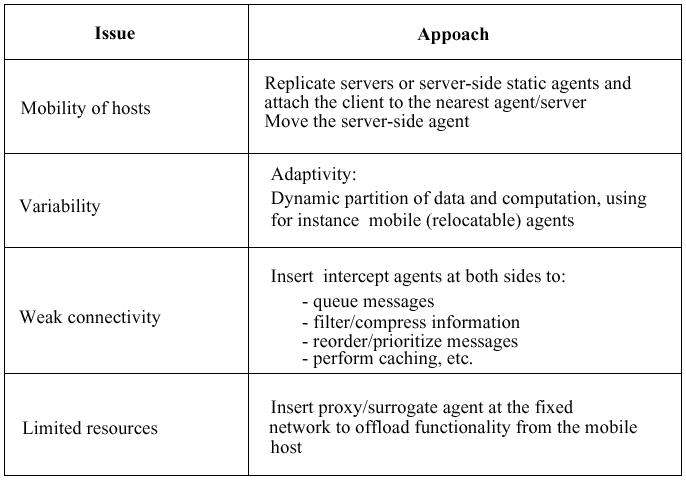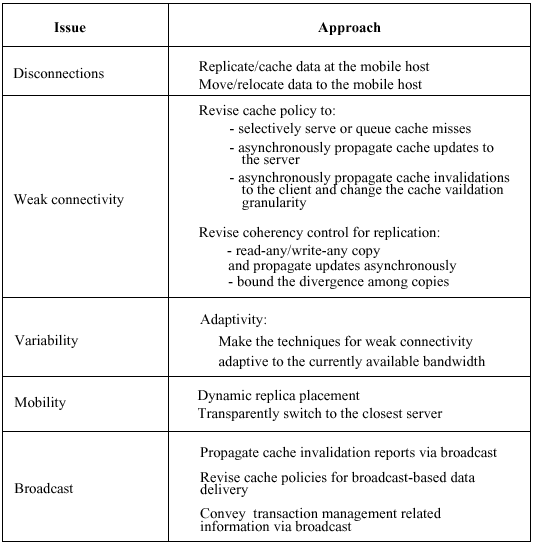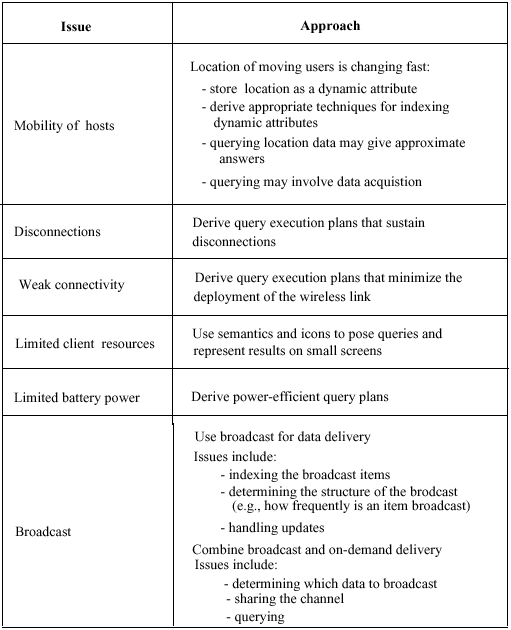[ Chapter 1 ] [ Chapter 2 ] [ Chapter 3 ] [ Chapter 4 ] [ Chapter 5 ] [ Chapter 6 ] [ Chapter 7 ] [ Index ]
Chapter 7 - Conclusions
- What is the best way to partition a computation as well as the functionality of a system or application between stationary and mobile elements?
Adaptivity: the functionality assigned to a mobile element must be made dependent on the resources currently available to it and on the present connectivity conditions.
- At which level should mobility be handled? What are the primitives, if any, that an operating system, a database management system, or an application must provide for treating mobility? Should the user be aware of any environmental changes?
Support for mobility at multiple levels, e.g., through a cooperation among the underlying systems and applications.
Need to effectively monitor: (a) location changes, and (b) changes in the availability of resources In attaining resource and location data, such a monitoring process cooperates with low-level system routines. Since this process is continuously active, its efficient implementation is not trivial.
In addition, an event-delivery mechanism to convey information about changes in the environment to interested applications.
Finally, define and implement primitives for an application to
(a) Communicate information related to its semantics and resource needs (e.g., level of acceptable consistency) to the underlying system, and
(b) Exercise control over the system's support for mobility (e.g., overwrite file-level prefetching)
- What is an appropriate model for mobile computing?
Provide constructs and primitives for moving computations. Adaptivity is handled by dynamically relocating computation on and off a mobile host.
Such constructs are provided either by the operating system (e.g., Tacoma Agent models must provide primitives at least for (a) Moving computation and data across different sites of the network, (b) Replicating computation and data at different sites, and
(c) Invoking operations on data located at remote sites. Agents should also encapsulate information related to their consistency and currency semantics. For instance, resolution procedures to be applied in case of
conflicting operations, or consistency conditions such as those in quasi copies.
- Extend the client/server models with agents/proxies
To handle weak connectivity and offload computation from the mobile client to the fixed network.
Proxies handle connectivity at various levels, e.g., at the transport level or at the file system level.
Techniques to handle weak connectivity include queuing incoming and outgoing messages, filtering information, compressing, batching together multiple requests, and reordering requests based on priorities.
Proxies can perform part of the computation in lieu of their clients.
Proxies may either be static or follow the majority of their clients when agents are static; mobility of clients is handled by replicating servers or proxies and attaching the client to the server/proxy located in its current neighborhood.
Summary

Which data and functionality to hoard? A promising approach is to relate hoarding in databases to view materialization. How to maintain consistency?
Optimizing the size of the log is critical in terms of performance and memory capacity for database operations. How to integrate the results. By re-executing the operation log at the fixed host.
In
file systems: (a) cache updates are deferred and transmitted in the background; (b) cache misses are queued, or selectively serviced; (c) the server sends invalidation reports massively at various degrees of granularities,
e.g. files or sets of files. Adaptive to the available bandwidth by varying: (a) the frequency of transmitting updates, (b) the number of misses serviced or queued, (c) the granularity at which cache invalidation is
performed.
- Weak connectivity in database systems?
What part of the database functionality to assign to mobile hosts.
Database fragmentation and fragment placement.
Mobile transaction model: an open-nested transaction model.
Other System-Level Issues
Broadcast
Use broadcasting to: - Transmit cache invalidation reports to clients.
- In concurrency control or other transaction management protocols
Mobility
At the system level, mobility in replicated file systems is handled by letting a client access copies from the servers located closest to it.
Mobility also affects algorithms for placing replicas. Relocating transactions in progress involves transmitting state-related information including locks or timestamps.
System-Level Support
Summary

Location
Location data (i.e., data items that hold information about the location of moving elements). Requires cooperation with
low-level (e.g., data-link or network layer) routines that maintain location information.
- Fast changing.
- Have both a spatial and a temporal dimension.
Data models that support dynamic attributes, e.g., attributes whose value changes with time. and New techniques for indexing them.
Approximate information: query processing may involve data acquisition or provide an approximate answer.
Disconnections and Weak Connectivity
That takes into account the fact that some sites may be only intermittently connected to the fixed network. Database interfaces for posing queries and
representing their results using small screens.
Broadcast
Instead of posing queries, clients listen to the broadcast channel and tune in to get the information they need. In a sense, instead of posing queries to the server, clients "filter" the broadcast. Techniques for structuring and indexing the broadcast information. Combined with on-demand delivery, in which case clients can also directly send requests for data to servers. Deriving optimal
query execution plans than involves both accessing the server and filtering the broadcast.

Locating Mobile Users
Various data management techniques can
be used to enhance location schemes: e.g., cache or replication. Further: cache replacement policies and/or prefetching. Dynamic algorithms for replica placement can be deployed to determine the sites of
replication. Concurrency control and failure recovery.
[1] L. Cardelli. A Language with Distributed Scope. Computing Systems, 8(1): 27-59, 1995. [2] D. Johansen, R. Renesse, and F. B. Schneider. Operating System
Support for Mobile Agents. In Proceedings of the 5th Workshop on Hot Topics in Operating Systems (HOTOS-V), May 1995. [3] A. D. Joseph, J. A. Tauber, and M. F. Kaashoek. Mobile Computing with the Rover Toolkit. IEEE
Transactions on Computers, February 1997. [4] J. E. White. Mobile Agents. General Magic White Paper, www.genmagic.com/agents, 1996.
[ Chapter 1 ] [ Chapter 2 ] [ Chapter 3 ] [ Chapter 4 ] [ Chapter 5 ] [ Chapter 6 ] [ Chapter 7 ] [ Index ]
[EPL651] [Course Contact] [Schedule & Readings] [Assignments] [Resources] [What's New]